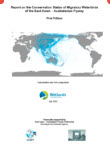
Report on the Conservation Status of Migratory Waterbirds of the East Asian – Australasian Flyway
-
Asian Waterbird Census
The East Asian – Australasian Flyway (EAAF) is one of the world’s major global waterbird flyways. The EAAF includes 276 migratory waterbird populations. The ranges of some populations extend to parts of the adjacent Central Pacific and Central Asian Flyways as well as populations that span large areas of the Indian and Pacific Oceans.
The East Asian – Australasian Flyway Partnership (EAAFP) provides the flyway-wide framework to promote dialogue, cooperation, and collaboration between a range of stakeholders to conserve migratory waterbirds and their habitats within the EAAF region.
The EAAF Conservation Status Report 1
Recognising the urgent need for updated waterbird population status information, EAAFP Partners adopted Decision 12 at MoP10 that requested Wetlands International to produce a 1st edition of the EAAF Conservation Status Report (CSR1), as a contribution to Objective 3 of the EAAFP Strategic Plan 2019-2028.
This is the first review of the conservation status of all EAAF migratory waterbird populations since the 5th edition of Waterbird Population Estimates (WPE5) in 2012. CSR1 covers 276 migratory populations of 216 waterbird species of 20 families. All current and historic population trends, sizes, 1% thresholds and population boundary maps are available through the Waterbirds Populations Portal. Populations of eight families of more pelagic waterbird species, including those recently added to the Partnership list will be included in future editions.
The report has been prepared by Wetlands International in collaboration with EAAF Partners, Working Groups, Task Forces, and experts from within and outside the flyway and jointly organised with the EAAF Secretariat. The preparation of the CSR1 has been generously supported by the EAAFP Secretariat and the Norwegian Environment Agency.
This report relies on data collected by thousands of volunteers and researchers. You can support their monitoring efforts by contributing to the Waterbird Fund.

